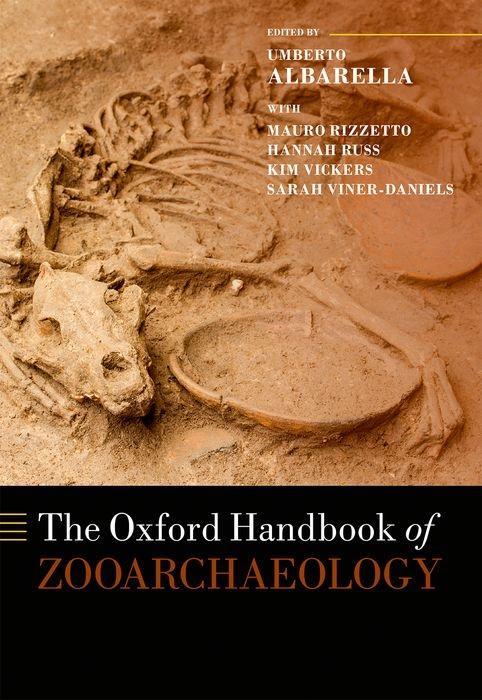
Zustellung: Di, 17.06. - Sa, 21.06.
Versand in 2 Wochen
VersandkostenfreiThe Oxford Handbook of Zooarchaeology offers a cutting-edge compendium of zooarchaeology the world over that seeks to provide a holistic view of the role played by animals in shaping human history, with case studies from five continents examining human-animal relationships across a range of geographical, historical, and cultural contexts.
Inhaltsverzeichnis
- Frontmatter
- List of Figures
- List of Tables
- Online Supplementary Material
- I. INTRODUCTION
- 1: Umberto Albarella: Zooarchaeology in the 21st century: where we come from, where we are now, and where we are going
- II. EUROPE
- 2: Mietje Germonpré and Mikhail V. Sablin: Humans and mammals in the Upper Palaeolithic of Russia
- 3: Katherine Boyle: The zooarchaeology of complexity and specialization during the Upper Palaeolithic in Western Europe: changing diversity and evenness
- 4: Lembi Lõugas: Mesolithic hunting and fishing in the coastal and terrestrial environments of the eastern Baltic
- 5: Jean-Denis Vigne: Archaeozoological techniques and protocols for elaborating scenarios of early colonization and Neolithization of Cyprus
- 6: Jörg Schibler: Zooarchaeological results from Neolithic and Bronze Age wetland and dryland sites in the Central Alpine Foreland: economic, ecologic, and taphonomic relevance
- 7: László Bartosiewicz: Zooarchaeology in the Carpathian Basin and adjacent areas
- 8: Paul Halstead and Valasia Isaakidou: Sheep, sacrifices, and symbols: animals in Later Bronze Age Greece
- 9: Jacopo De Grossi Mazzorin and Claudia Minniti: Changes in lifestyle in ancient Rome (Italy) across the Iron Age/Roman transition: the evidence from animal remains
- 10: Konrad Smiarowski, Ramona Harrison, Seth Brewington, Megan Hicks, Frank J. Feeley, Céline Dupont-Hébert, Brenda Prehal, George Hambrecht, James Woollett, and Thomas H. McGovern: Zooarchaeology of the Scandinavian settlements in Iceland and Greenland: diverging pathways
- 11: Dale Serjeantson: Fishing, wildfowling, and marine mammal exploitation in northern Scotland from prehistory to Early Modern times
- 12: Simon J. M. Davis: Zooarchaeological evidence for Moslem improvement of sheep (Ovis aries) in Portugal
- 13: Finbar McCormick and Emily Murray: The zooarchaeology of Medieval Ireland
- 14: Terry O'Connor: Animals in urban life in Medieval to Early Modern England
- 15: Mark Maltby: From bovid to beaver: mammal exploitation in Medieval north-west Russia
- III. ASIA
- 16: Joris Peters, Nadja Pöllath, and Benjamin S. Arbuckle: The emergence of livestock husbandry in Early Neolithic Anatolia
- 17: Canan Çak rlar and Levent Atici: Patterns of animal exploitation in western Turkey: from Palaeolithic molluscs to Byzantine elephants
- 18: Ajita K. Patel and Richard H. Meadow: South Asian contributions to animal domestication and pastoralism: bones, genes, and archaeology
- 19: Li Liu and Xiaolin Ma: The zooarchaeology of Neolithic China
- 20: Norbert Benecke: Subsistence economy, animal domestication, and herd management in prehistoric central Asia (Neolithic - Iron Age)
- 21: Hitomi Hongo: Introduction of domestic animals to the Japanese archipelago
- 22: Charles F. W. Higham: Farming, social change, and state formation in south-east Asia
- 23: Justin E. Lev-Tov and Sarah Whitcher Kansa: The zooarchaeology of early historic periods in the southern Levant
- IV. AFRICA
- 24: Ina Plug: Middle and Later Stone Age hunters and their prey in southern Africa
- 25: Diane Gifford-Gonzalez: Pastoralism in sub-Saharan Africa: emergence and ramifications
- 26: Louis Chaix: Cattle, a major component of the Kerma culture (Sudan)
- 27: Shaw Badenhorst: The zooarchaeology of Iron Age farmers from southern Africa
- 28: Veerle Linseele: The exploitation of aquatic resources in Holocene West Africa
- 29: Salima Ikram: Animals in ancient Egyptian religion: belief, identity, power, and economy
- 30: Michael MacKinnon: Animals, acculturation, and colonization in ancient and Islamic North Africa
- 31: Adam R. Heinrich: Historical zooarchaeology of colonialism, mercantilism, and indigenous dispossession: the Dutch East India Company's meat industry at the Cape of Good Hope, South Africa
- V. NORTH AMERICA
- 32: Gregory G. Monks: Zooarchaeology of the pre-Contact Northwest coast of North America
- 33: Rebecca M. Dean: Fauna and the emergence of intensive agricultural economies in the United States south-west
- 34: John D. Speth: 13,000 years of communal bison hunting in western North America
- 35: Joaquín Arroyo-Cabrales and Eduardo Corona-M.: Advances in hunter-gatherer research in Mexico: archaeozoological contributions
- 36: Tanya M. Peres: The exploitation of aquatic environments by the Olmec and Epi-Olmec
- 37: Heather A. Lapham: Tracking the trade in animal pelts in early historic eastern North America
- 38: Elizabeth J. Reitz: Animal use at early colonies on the south-eastern coast of the United States
- 39: Kitty F. Emery: Zooarchaeology of the Maya
- VI. SOUTH AMERICA
- 40: Peter W. Stahl: Zooarchaeological approaches to Pre-Columbian archaeology in the neotropics of north-western South America
- 41: Daniela Klokler: Zooarchaeology of Brazilian shell mounds
- 42: Guillermo L. Mengoni Goñalons: Camelid hunting and herding in Inca times: a view from the South of the empire
- 43: Luis A. Borrero: Forests, steppes, and coastlines: zooarchaeology and the prehistoric exploitation of Patagonian habitats
- VII. OCEANIA
- 44: Matthew Leavesley: Pleistocene adaptations in tropical rainforest environments in Island Melanesia
- 45: Richard Cosgrove and Jillian Garvey: Behavioural inferences from Late Pleistocene aboriginal Australia: seasonality, butchery, and nutrition in south-west Tasmania
- 46: Ian Smith: Regional and chronological variations in energy harvests from prehistoric fauna in New Zealand
- 47: Melinda S. Allen: Spatial variability and human eco-dynamics in central-east Polynesian fisheries
- Endmatter
- A Glossary of Zooarchaeological Methods
- Notes on Contributors
- Index
Mehr aus dieser Reihe
Produktdetails
Erscheinungsdatum
23. Mai 2017
Sprache
englisch
Seitenanzahl
866
Reihe
Oxford Handbooks
Herausgegeben von
Umberto Albarella, Mauro Rizzetto, Hannah Russ, Kim Vickers, Sarah Viner-Daniels
Verlag/Hersteller
Produktart
gebunden
Gewicht
1860 g
Größe (L/B/H)
249/173/51 mm
ISBN
9780199686476
Entdecken Sie mehr
Pressestimmen
This book is another manifestation of and for the global community of zooarchaeology. Eve Rannamäe, ICAZ NEWSLETTER
Bewertungen
0 Bewertungen
Es wurden noch keine Bewertungen abgegeben. Schreiben Sie die erste Bewertung zu "The Oxford Handbook of Zooarchaeology" und helfen Sie damit anderen bei der Kaufentscheidung.































